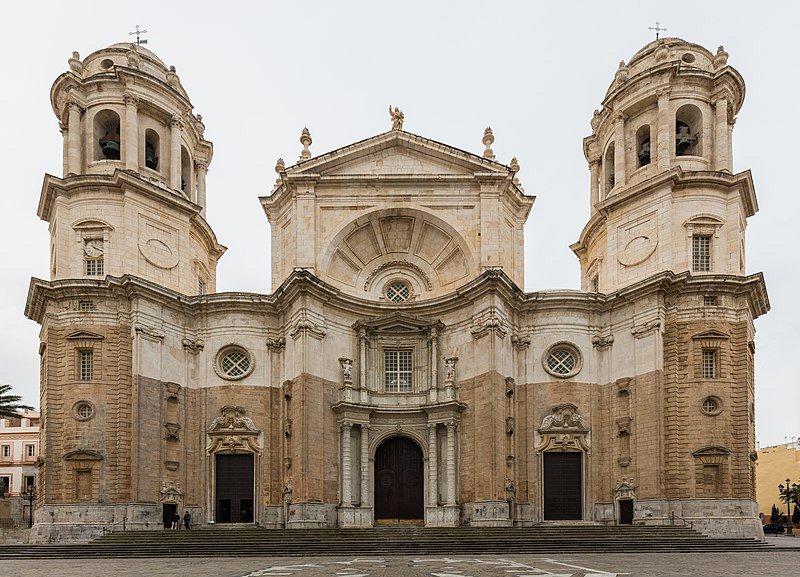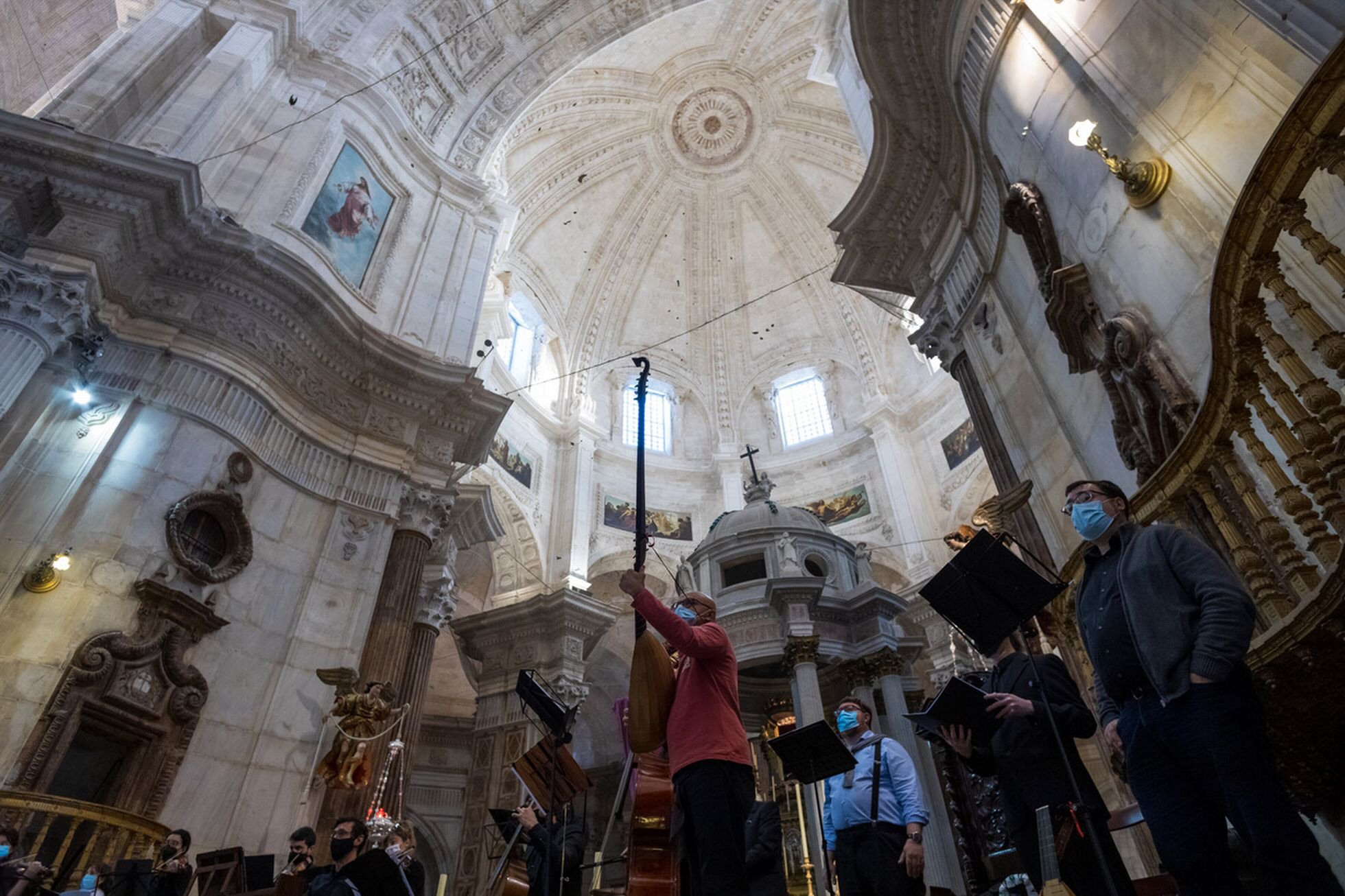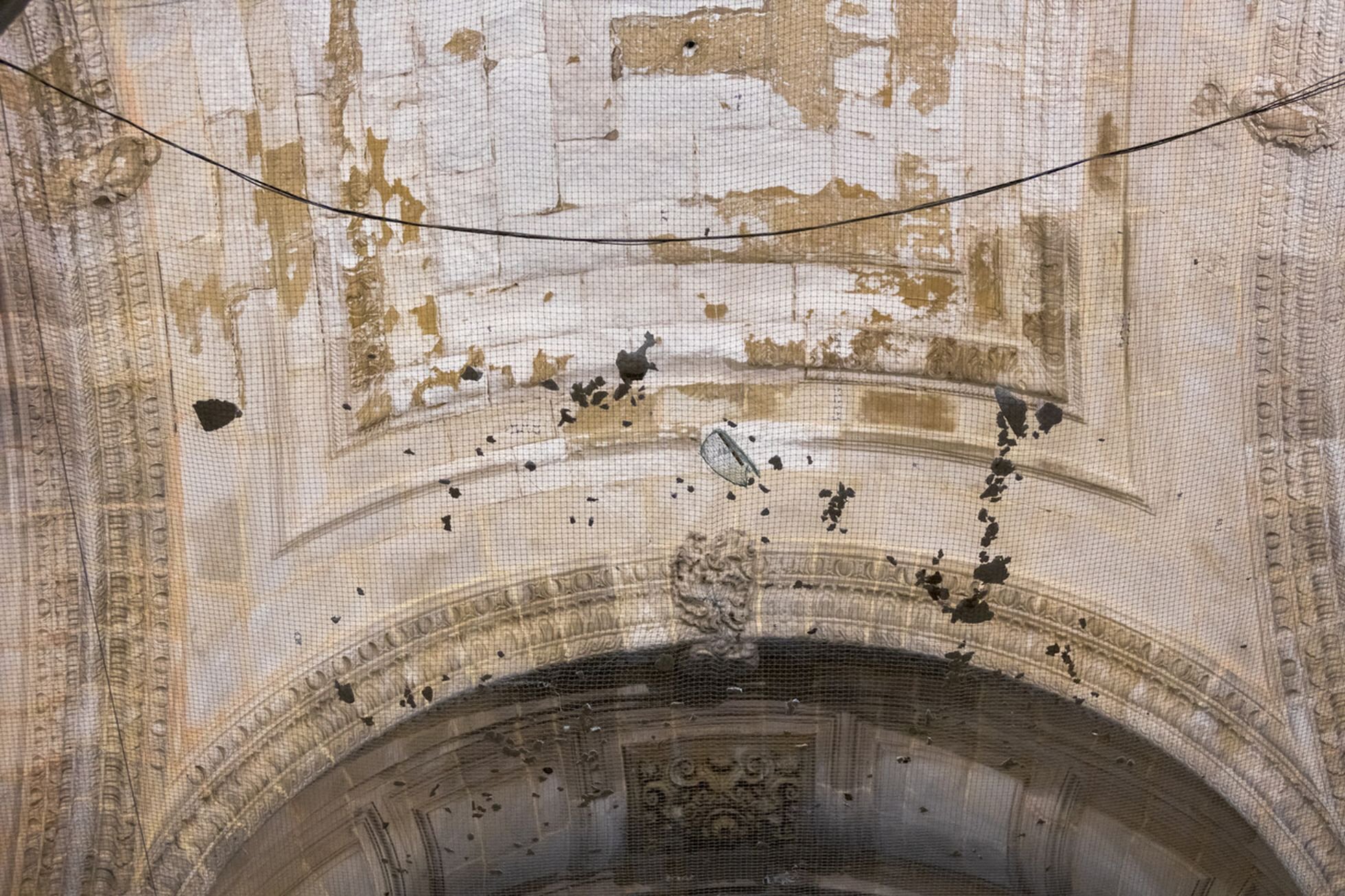In 1720 the port of Cádiz made the decision to build a Cathedral that would reflect its growing prosperity. Trade with the Americas had enriched the city, and it was felt that some of these riches should go to the construction of a building that would rival, or be better than other inland cities. The drawings of Architect Vicente Acero were approved, and he directed the laying of the foundations and crypt in 1722. To mix their mortar the tradesmen used the abundant sand available on the nearby beaches and the brackish water from an old well that had been a part of the older buildings which had been demolished when they cleared the site.
Unknowingly, they had added disaster into their cement, because both the water in the well and the sand from the beaches was full of salt. Indeed, it was later discovered that if mortar had been mixed with water from the well at high tide, there was enough salt in the mix to stop it setting. Worse was to come. Over the years, as the work progressed, the fortunes of the port declined, and the grand plans for the Cathedral became an embarrassment and a target for cost-cutting. Instead of good quality stone, the builders were instructed to use Estepa limestone, a cheaper alternative. Acero had used good stone for the initial construction, but from the very beginning the building had been flawed by the mixing of salt into the mortar. The salt dissolved with humidity, and the lime turned to dust, leaving hard spots in the mortar between the stones. The huge weight of the building above focused the load through the hard spots and cracked the stone. The cathedral’s proximity to the sea added to the problem. When winter storms enveloped the building with salt laden spray, the salt was absorbed by the poorer quality stone. But in the heat of summer, the salt within the stone crystallized, making the stone crumble. Vicente Acero left the project, and a string of other architects took over, changing the Baroque style to Neoclassicism. But 90 years after the first stone had been laid for the cathedral, the future of the port, and indeed all of Spain and Portugal, was in grave jeopardy.
By 1812, Cádiz was the last stronghold of Spanish Cortes Generales, (General Courts) and Spain’s resistance to the occupying French troops of Napoleon. On the 19 March that year, the Cortes established the principles of universal male suffrage, national sovereignty, constitutional monarchy and freedom of the press, and supported land reform and free enterprise. It is popularly known by the name "Constitution of Cádiz", or the “Pepa”. Many of the American possessions, from which Cádiz had gained its wealth, declared independence. Worse was to come. When Napoleon was defeated at great cost to the people of Spain, King Ferdinand VII was restored to power, and on 24 March 1814, six weeks after returning to Spain, he abolished the constitution and had all monuments to it torn down. He replaced all the liberal politicians with his own aristocratic and very rich cronies, who commenced to impose their old-style rich versus exploited-poor agenda. Years of national poverty followed the betrayal. This was Spain’s darkest hour, and nobody in Cádiz spared a thought for their half-built cathedral.
For 40 years the cathedral stood without a roof and open to the elements, which slowly began to erode the poorest of the 27 types of stone the building had been constructed with. Eventually, work did start again. New architects were employed and masons attempted to make good the damage caused by the weather. The cathedral was given a roof, and was finally finished and consecrated in 1838, to the acclaim and satisfaction of the people of Cádiz.
 Photo: Diego Delso.
Photo: Diego Delso.
Three months after the consecration, father Domingo González Villanueva was inspecting the vaulted roof when he made an alarming discovery. He alerted the church officials to the fact that “stone slabs and somewhat larger pieces are falling.” For the next hundred years the chapter of the cathedral made attempts to remedy the problems, but the ever present salt confounded their efforts.
General Franco came to power in Spain, and the years after the Spanish Civil war and the Second World War were “the years of hunger” for the Spanish, as it was with nearly all the other counties in Europe. But for Cádiz Cathedral, things were going from bad to worse. In 1947 an accidental explosion blew out all the windows. There was no money to replace them, and for years salt laden air blew through the interior of the building once more, insidiously seeping into the stone. Though the windows were eventually replaced, the salt had accelerated the deterioration of the stone. Pieces of the vaulted ceiling began to fall with alarming regularity, and the cathedral was closed to the public in 1969 and was not opened again until 1983. The problem had not gone away, and in 1989, just days before the cathedral was due to be full of worshipers celebrating a First Communion mass, a large block of masonry fell and smashed one of the pews. The chapter of the cathedral decided to install of net throughout the whole building to catch the pieces before they hit the ground. The net is periodically emptied, but nobody knows how big a piece of masonry it will stop, and the fear is that eventually a heavy piece will fall and bring the net down with it. Juan Jiménez Mata, the architect who installed the net over 30 years ago, and who is responsible for the upkeep of the cathedral, is unable to say how much weight it would stand in the event of a major incident.

The nets installed inside the cathedral catch the smaller pieces of masonry. Photo : Juan Carlos Toro, El Pais.
Early this year, a large piece of masonry came loose from the façade and landed in the cathedral’s courtyard, mercifully without causing injury. But it is a wake-up call to the Junta de Andalusia that things are reaching a critical point.
A decade ago, at the request of the cathedral’s college of clerics and the regional government, Mata wrote a report listing priorities and laying out how the restoration work should be tackled. After installing the net, he has overseen repair work in which the empty joints are filled with new mortar, and the fallen stones are replaced with new masonry. So far, he has restored the lower sacristy and the Chapel of the Relics, but it has been a decade since any significant restoration work has been carried out on the crumbling vaults. Mata’s report estimated repair work to the 3,100 square meters of roof would cost €15 million. During this time, neither the regional nor the central authorities have come up with the necessary funding, although from 1998 to 2009 they invested €1.5 and €2.3 million respectively in other restoration projects.
El País has asked the culture department’s representatives in Cádiz why the recommendations of Mata have not been implemented, and strangely, they had no idea why the architect’s plan has still not been approved. Meanwhile, the cathedral chapter’s efforts have been focused on annual maintenance for the roofs and on emptying the net. To be fair, the Cádiz Culture Delegation have paid for various restoration projects during this period, the last of which concerned the Chapel of the Assumption, the first in the cathedral to be built. Fabián Pérez, who has regularly collaborated in the cathedral’s restoration work as part of the Ars Nova studio, says that, “The chapter’s efforts to restore movable and immovable assets is remarkable. It hasn’t stopped even with the pandemic.”
But the authorities holding the purse strings have dismissed requests from El País to explain how much they have invested and whether they following Mata’s list of priorities.
Meanwhile, Juan Jiménez Mata and his son Alberto are concerned that no funding for work on the crumbling vaults is forthcoming. “There should be a group of contracted masons, led by an architect, constantly reviewing roofs and cornices,” says Juan. Alberto adds, adds, “We are not asking for the work to be entrusted to us, but we do ask that the people who intervene in the restoration of historical heritage be assessed with transparency and a public tender.” Alberto adds ominously, “Pieces of rubble continue to fall, but the size of them is a lottery.”

Photo: Juan Carlos Toro, El País.
The salt curse of Cádiz Cathedral continues apace, with the authorities charged with its upkeep dragging their feet. The solution to the problem is available, but expensive, and as with so many situations like this, things will only be jarred into action when somebody is killed.
Taken from El Pais, with acknowledgements to Heather Galloway.